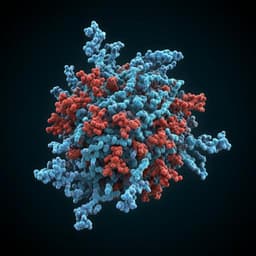
Chemistry
Predicting chemical exfoliation: fundamental insights into the synthesis of MXenes
J. Björk, J. Halim, et al.
This groundbreaking research by Jonas Björk, Joseph Halim, Jie Zhou, and Johanna Rosen delves into the chemical exfoliation of MAX phases to create MXenes, emphasizing the pivotal role of selective A element removal in hydrofluoric acid. Their innovative approach combines theoretical calculations with experimental data to reveal essential insights for the discovery of novel two-dimensional materials.
~3 min • Beginner • English
Introduction
MXenes (2D transition-metal carbides/nitrides) are produced by selectively etching A layers from layered MAX phases, most commonly using HF. Although many combinations of transition metal (M), X (C and/or N), and surface terminations (T) are possible, only specific MAX precursors yield MXenes under chemical etching, and the governing factors remain unclear. Prior computational efforts showed weaker M–A than M–X bonds and proposed exfoliation energies using elemental A references, but these approaches could not explain thermodynamic driving forces toward MXene formation. Electrochemical analyses (Pourbaix diagrams) indicated MXene stability at higher pH and certain potentials, inconsistent with conventional acidic HF syntheses and with MXene degradation in water. This raises doubts about thermodynamic stability against solvation as a predictor and highlights the need to impose electroneutrality for chemical (nonelectrochemical) etching. The present work addresses these gaps by combining DFT formation energies of MAX/MXene solids with tabulated aqueous formation energies of molecules/ions to model HF etching at defined pH and concentrations under electroneutrality, and by comparing predictions to literature and new experiments on phases that failed to yield MXenes. The goals are to identify descriptors that rationalize and predict which MAX phases are chemically exfoliable and why.
Literature Review
- Early MXene syntheses involved HF etching of Al from Ti3AlC2 to yield Ti3C2Tx; other protocols include HCl/LiF, HF/HCl, HF/H2O2, and molten salts. Chemical exfoliation has also produced other 2D materials (e.g., boridene).
- Khazaei et al. and Khaledialidusti et al. computed exfoliation energies and showed M–A bonds are weaker than M–X, but referenced A elements to elemental bulk phases, yielding positive formation energies from MAX to MXene even for experimentally realized MXenes, leaving the thermodynamic driving force unresolved.
- Ashton et al. used Pourbaix diagrams to predict electrochemical synthesis windows where MXenes are stable versus dissolved species, often favoring high pH, which conflicts with conventional HF conditions; stability against solvation is questionable as a synthesis descriptor given observed MXene degradation in water and non-electrochemical processing.
- The field has largely overlooked electroneutrality in modeling chemical (non-electrochemical) exfoliation. This study incorporates it explicitly and contrasts predictions with both literature and new negative etching attempts (Mo2GaC, Mn2GaC, Zr2AlC).
Methodology
- Thermodynamics framework: Combined periodic DFT formation energies of MAX phases and MXenes with tabulated aqueous formation free energies (NBS tables, Pourbaix’s Atlas) for solvated ions/molecules, modeling HF(aq) conditions under electroneutrality at specified pH and solute concentrations.
- Definitions:
- Exfoliation free energy (per atom) for Mn+1AX → Mn+1XTz + A (z=0 or 2 terminations): ΔG_exf = [ΔG(Mn+1X Tz) + μ(A) − ΔG(Mn+1AX) − z μ(T)]/(2n+2).
- Solvation free energy (per atom) to fully dissolve MAX: ΔG_solv = [ (n+1) μ(M) + μ(A) + n μ(X) − ΔG(Mn+1AX) ]/(2n+2).
- Vacancy formation free energies for initial etching step: ΔG_A or ΔG_M = ΔG(Mn+1AX + defect) + μ(A or M) − ΔG(Mn+1AX), using large supercells (two A layers out-of-plane; 4×4 in-plane) to remove a single A or M atom.
- Chemical potentials μ of elements in solution: constructed by evaluating all relevant aqueous molecules/ions containing the element with H/F/O (and including the elemental reference phase when needed) and selecting the lowest chemical potential consistent with electroneutrality; explicit pH dependence included for H+ and a pH-dependent μ(F) (via HF/F−/HF2− equilibria). Example: at pH=0, μ_Al = ΔfG(AlF3(aq)) + ½ΔfG(H2(g)) − 3ΔfG(HF(aq)). Formation free energies for species at concentration C use ΔG(T,C)=ΔG°(T)+kBT ln C.
- Constraints to reflect acidic HF etching: two analyses were performed—(i) without constraints on oxygen-containing species and (ii) excluding oxygen-containing species (no oxides/hydroxides), recognizing limited availability of OH− at low pH and slow water activation.
- DFT details: VASP with PAW, PBE-GGA, 520 eV plane-wave cutoff, k-point spacing <0.2 Å−1. Spin-polarized with FM and two AFM initializations. MAX/MXene defect-free phases in p(2×2); MXenes include ≥15 Å vacuum out-of-plane; surface terminations with O and F tested on hollow sites. Stepwise etching calculations used p(4×4) in-plane and two MXene units out-of-plane to model removal across entire A layers. Entropy corrections for gas-phase H, O, N, F applied from tabulated data.
- Conditions for reported thermodynamic comparisons: pH=0 and ion concentration 10^−3 mol dm^−3 unless otherwise specified.
Key Findings
- Complete exfoliation thermodynamics:
- Including surface terminations (primarily O, occasionally F) renders ΔG_exf negative for all 23 MAX phases studied, often in the range −0.5 to −1.5 eV per atom; without terminations, most ΔG_exf remain negative but with notable positive cases (Mo2GaC, Mn2GaC, Ti2SnC, V2GaN), none of which have been experimentally exfoliated.
- Solvation free energies ΔG_solv are generally negative and lower (more favorable) than ΔG_exf, aligning with eventual MXene dissolution in solution; a key exception is Mo2GaC with positive ΔG_solv, consistent with experiments showing structural integrity in HF.
- Initial etching descriptor (vacancy formation):
- Without constraints, materials in the quadrant with ΔG_A<0 and ΔG_M>0 are generally exfoliable; discrepancies (e.g., Ta2AlC, Ta4AlC3) are resolved when excluding oxygen-containing species.
- With the no-oxide constraint (reflecting acidic HF kinetics), exfoliable MAX phases show ΔG_A<0 and ΔG_M>0. Non-exfoliable phases (e.g., Cr2AlC, Mn2GaC, Zr2AlN) remain with ΔG_M<0 (M dissolution favored), predicting lack of selectivity.
- Predicted non-exfoliable (in HF) among untested: Hf2AlC and V2GaN (due to ΔG_M<0). Zr2AlC and Mn2GaC dissolve completely (validated by present experiments).
- Exception: Mo2ScAlC2 exhibits favorable etching for both A and certain M species (Sc), matching observations of partial Sc etching.
- Mo–Ga carbides case study:
- Only Mo2Ga2C exfoliates to Mo2C MXene; Mo2GaC resists exfoliation. Stepwise A-layer removal reveals Mo2GaC is endergonic through ~30% Ga removal before becoming exergonic, while Mo2Ga2C becomes favorable early and proceeds via repeated four-step cycles: remove Ga (ΔG↑), remove Ga (ΔG↓), add O (ΔG↓), add O (ΔG↓), alternating between the two Ga layers. This pathway avoids forming inert Mo2GaC and rationalizes the slow but feasible exfoliation of Mo2Ga2C.
- Elemental solvation trends (HF, pH=0):
- A elements: Al has the most favorable solvation (especially without oxides), explaining its widespread successful removal; Ga, In less favorable.
- M elements: Mo does not dissolve even allowing oxides; Nb and Ta also resist dissolution when oxides are excluded—these M’s are most compatible with selective A etching. Sc, Zr, Hf have very negative solvation energies, hindering MXene formation. Ti, V, Cr, Mn are intermediate; strong M–X bonding can help prevent M dissolution—consistent with Ti carbides being synthesizable while Ti nitrides are not under HF.
- New experimental observations: Mo2GaC remains intact in HF over extended periods; Mn2GaC and Zr2AlC dissolve entirely without forming MXenes. These align with the thermodynamic analyses.
Discussion
The study demonstrates that overall thermodynamic favorability of complete MAX-to-MXene conversion (especially with terminations) is not sufficient to predict exfoliability because dissolution competes and often dominates. Instead, the selectivity in the initial etching step is critical: MAX phases that show exergonic A removal and endergonic M removal under acidic HF constraints are the ones that chemically exfoliate. Enforcing a no-oxide constraint better reflects the kinetics in strongly acidic HF where water activation is limited; this shifts predictions into agreement with observed behavior (e.g., Ta–Al carbides becoming exfoliable, Cr2AlC remaining non-exfoliable). The detailed comparison of Mo2GaC vs Mo2Ga2C reveals how layer stacking and stepwise energetics control feasibility, explaining why only the double-Ga-layer MAX leads to Mo2C MXene. Elemental solvation trends provide a high-level screening heuristic: easily solvated A elements (e.g., Al) and M elements resistant to dissolution (Mo, Nb, Ta) favor selective etching, while highly soluble M’s (Sc, Zr, Hf) impede MXene formation. These insights offer a pathway to prioritize candidates for computational and experimental exploration and suggest that adapting the chemical environment (beyond HF) could enable new MXenes by tuning the balance between A and M dissolution pathways.
Conclusion
By combining DFT-calculated solid formation energies with tabulated aqueous thermodynamics under electroneutrality, the work clarifies why some MAX phases exfoliate to MXenes in HF and others do not. While complete exfoliation with surface terminations is thermodynamically favorable for all studied MAX phases, this alone does not predict success. A robust descriptor emerges from the initial etching step: ΔG_A<0 and ΔG_M>0 (under acidic, no-oxide conditions) identifies exfoliable cases, aligning with literature and new negative experiments. The Mo2Ga2C vs Mo2GaC case highlights how layer-specific energetics govern feasibility. Elemental solvation trends capture the broader landscape, indicating that Al is readily removed, and M elements such as Mo/Nb/Ta are preferred for preserving the MXene substructure, whereas Sc/Zr/Hf hinder synthesis. Future work should extend this electroneutral, solution-thermodynamics-based framework to other etchants and conditions, incorporate kinetic factors and microstructural pathways (e.g., grain boundaries), and leverage these descriptors for high-throughput screening of chemically exfoliable 2D materials.
Limitations
- The thermodynamic analysis focuses on HF at low pH (typically pH=0) and fixed ionic strength (10^−3 mol dm^−3); other etchants/environments may alter species stability and reaction pathways.
- A key approximation excludes oxygen-containing species to reflect limited water activation in strong acid; real systems may exhibit some oxidative pathways depending on impurities or added oxidants.
- Kinetic barriers and microstructural effects (e.g., grain boundaries, defects, particle size) are not explicitly modeled; vacancy formation and layer-removal steps approximate initial stages and average behavior.
- The stepwise etching model assumes initiation within the bulk rather than explicit surface/grain boundary initiation; detailed interfacial and transport phenomena are beyond scope.
- Predictions are thermodynamic; some systems may be kinetically inhibited despite favorable ΔG, or conversely proceed via metastable intermediates.
- DFAs (PBE) and chosen terminations (O, F) may not capture all possible surface chemistries or solvent interactions; entropy of solvated solids is not included beyond tabulated species.
Related Publications
Explore these studies to deepen your understanding of the subject.







